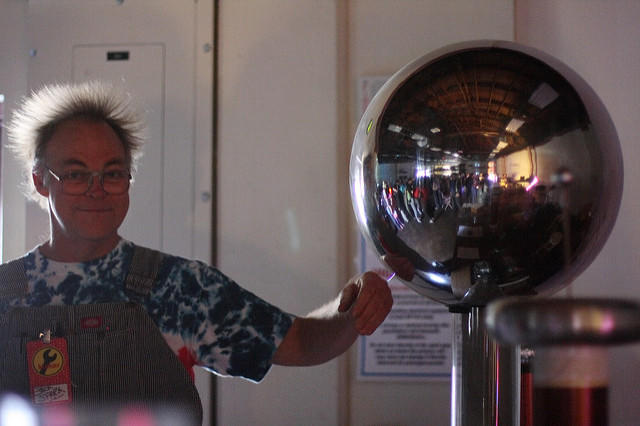"We forget just how painfully dim the world was before electricity. A candle, a good candle, provides barely a hundredth of the illumination of a single 100 watt light bulb." -Bill Bryson
Try to imagine a world without electricity: no light, no televisions, no heating during the winter or cooling in the summertime, no internet or no hot water while taking a shower.
In all honesty, the world would be a pretty grim place. Nevertheless, for centuries, men and women lived without this useful commodity. People in ancient times used candlelight and woodfires to accomplish daily tasks.
Through the study of Physics electricity can be thoroughly understood by students of all ages.
When we think of the physics curriculum that is thought across Irish secondary schools and college campuses all around the country, electricity is a topic that never fails to fascinate students and is often a gateway that pulls students into some of the more complex components of the course.
In Ireland, the Leaving certificate Physics option is offered to students who are nearing graduation and who have scientific interests.
One of the most popular topics amongst students across the Physics Syllabus is electricity and the basic concepts are taught to pupils to further their knowledge of the subject. Superprof is here to analyze the four sections covered in this second topic of the Leaving Cert Physics subject.


What exactly is electricity?
Electricity is a topic that many students will have some degree of prior knowledge of before studying the leaving certificate physics course at any capacity in school.
When we think of electricity we generally think of it as something that comes out of the wall sockets in our homes and makes the lights and our devices turn on. We also all know that it can sting and hurts if you are unlucky enough to touch it.
We all have our anecdotal justifications and preconceived notions for why this is, but through delving into the topic of electricity at school you can find out the science behind this misfortune and much more!
Physics tells us so much about the world around us and answers so many questions that we might have surrounding the topic of electricity.
Some of the most common components on an electric circuit include the following:
- Switch: a very simple component used to turn a circuit on and off.
- Lamp: an electric current heats a bulb so that it can give out some light.
- Fixed Resistor: restricts or limits the flow of electrical current. The fixed resistor has a resistance that will never change.
- Variable Resistor: used for some dimmer switches and volume controls. Moving the position of the slider causes it to change.
- Thermistor: resistance depends on the temperature. When the temperature is low the resistance is elevated and when the temperature is high the resistance decreases. Used in fire alarms or thermostats in the house.
- Light-dependent resistor (LDR): resistance depends completely on light intensity. On lower light levels, the LDR has a higher resistance and as the light increases the resistance decreases. Used as a sensor in cameras or automatic lights.
- Semiconductor diode: allows current to flow in only one direction and it will never flow in the opposite direction.
Students also learn a lot more about potential difference which is the measure of how much energy is transferred between two points on a circuit. To measure the potential difference of an electric circuit a voltmeter needs to be placed in parallel with the component that is being measured.
The potential difference can be calculated by using a basic equation such as the following:
potential difference = energy ÷ charge or 
The potential difference (V) is measured using volts, energy (E) is calculated by using joules and charge (Q) is measured in coulombs.
Required Practical
During this section on the topic of electricity, pupils must complete three required practical exercises:
- Investigate the factors that affect resistance: in this practical exercise, pupils work towards the aim of this experiment which is to investigate how changing the length of the wire affects its overall resistance.
- Investigate current-voltage graphs: in this scientific experiment, scholars observe a series of diagrams and then complete the nine steps that are part of the method.
- Investigate resistor networks: in this practical exercise, students discover that there is more than one way to investigate resistor networks. They record potential differences and current in an accurate manner and use appropriate apparatuses and methods to measure the potential differences.
Your maths and physics tutor can help you understand the laws governing resistance and how to calculate it!

Understanding Electricity through Physics
You may have wondered why we get a shock when we touch a doorknob? Or why lightning looks like electricity. Delving into the topic of electricity in your leaving cert physics book will provide answers for all of this.
Understanding electricity and its properties are perhaps the first steps in attaining a well-rounded knowledge of the material. If you have studied science at the junior cert level then you will know that everything in the world is made up of tiny particles called atoms.
These atoms are in fact so small that they cannot be seen even with a microscope. They are made of two kinds of electric charge. Found in the centre of atoms are the positive charges and flying around the outside are the negative charges. Largely speaking, there are just as many positive charges as negative charges.
In some instances, there are too many of either kind of charge, and the charges go looking for a companion. The negative charges are called electrons, they move around the atom freely as they are not very tightly fixed. It is these electrons that make up what we call electricity. There are two kinds of electricity: static and current.
We all know static electricity as the force that makes our hair stand up when we rubbed balloons against it as kids. You might also know static electricity for the shock that you get from your doorknob.
In static electricity, electrons are moved around mechanically such as through friction between two objects.
Under the topic of electricity in your leaving cert textbook for physics you will learn about the process behind this, explaining how when you drag your feet across the carpet, extra charge is scraped off the carpet and is collected on your body. When you touch a doorknob, all the charge wants to leave you and go to the doorknob. This is what leaves us with that shocking sensation as the electrons leave you.
This is certainly one of the more fascinating topics that you will get to delve into as part of the leaving cert physics program!

Opportunites in physics across Ireland
There are countless options for college courses that you can take at university if you are pursuing a career in teaching physics. DCU is certainly one of the top choices that you should be considering if you are serious about becoming a physics teacher and securing full-time or part-time employment teaching the subject.
Let’s take a quick look at the general physics that the college has on offer to students. First of all, you’ll have access to some of the best facilities that the country has to offer and experienced lecturers that will teach you just as much about teaching as physics. You're bound to pick up a number of tricks in your lectures!
Studying a physics degree often presents students with a comprehensive knowledge of the core elements of the subject, allowing you to go above and beyond the leaving cert curriculum. The course includes maths for physical sciences, linear mathematics, calculus, differential equations as well as some abstract algebra.
The course is a NFW level 8 degree and is full time too! The minimum entry requirement is approximately 400 CAO points if you wish to secure a place on the course, but this is likely to deviate slightly depending on the demand. I would certainly recommend that you consider DCU if you are wondering how you can become a physics teacher in Ireland.
Electric Fields, learn more with a tutor from Superprof!
All charged objects have an electric field around them with different shapes.
An electric field is where charges experience a force and they are usually shown on diagrams with arrows to show in which direction a positive charge will be pushed.
The closer the arrows are the stronger the field and the greater the force will be experienced by charges in that certain field.
The Leaving Cert Physics Syllabus is extremely well designed to provide students with all the basic concepts of physics in a logical manner. Whether you are a scientific brain or just want to learn more, this secondary school subject is a great choice for anyone!
Note: You can find an online Physics tutor on Superprof.
Studying the electricity topic provides pupils with interesting information that will cause them to further grasp the fundamentals of physics and understand the basics of turning on a light or boiling water on an electric stove.
Other key topics of the Leaving Certificate Physics Syllabus include particle model of matter, atomic structure, forces, waves, magnetism and electromagnetism and space physics.















